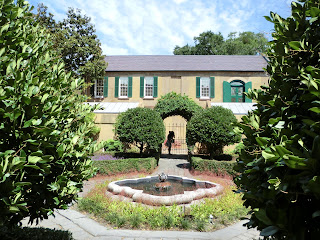When James Edward Oglethorpe chose the location of present day Savannah for the site of the new colony of Georgia, in 1733, he made his selection because it was on easily defended high ground, the bluff allowed large ships to draft near the bank, and there was a good source of fresh water. The Yamacraw Indians, led by Tomochichi welcomed the colonists to settle on the bluff high above the Savannah River.
Oglethorpe knew a thing or two about city planning when he laid out the design for Savannah, Georgia. With the help of Charleston civil engineer, William Bull, Savannah was arranged on the 'ward plan'. Each ward had a central square, four tything lots in each corner for residences and trust lots flanking either side of the square for civic and commercial interests. Then, the ward could be replicated over and over as the city grew. The result was 24 squares and a city that ebbs and flows with a beautiful, syncopated rhythm that is a joy to explore, especially on foot.
On our first day, we explored the city aboard an Old Town Trolley's hour and a half, narrated tour plus two historic home tours.
The Davenport House, built by Isaiah Davenport, a Rhode Islander who brought New England building ideas to the city and as a master builder constructed this fine example of the Federalist style of architecture. Its impending demolition in 1954, spawned the formation of Historic Savannah Foundation, a formidible voice in the preservation of the city.
The Owens-Thomas House, designed by William Jay, a young English architect, who at age 23, in 1817, brought a 'bright new day' to Savannah architecture. His houses and buildings are among the finest to be found in the city. This house on Oglethorpe Square features a 'graceful portico' which is 'but an introduction to the startlingly handsome and imaginative interior'.
Lunch at the nearby 17hundred90 Restaurant was a delicious way to experience our first Shrimp and Grits, a must-eat when in Savannah!
Days 2 & 3 were spent on a walking tour of the city, using the 'The Savannah Walking Tour & Guidebook' available at Amazon or most gift shops throughout the city. It divides Savannah into four unique walking tours: 1. Along the Riverfront-45 min., 2. The First Squares-1 hr. & 15 min., 3.Squares of Luxury-1 hr., 4.The Booming West Side-35 min.
On Day 2, we were able to complete walks 1 & 4.
The First African-American Baptist Church is home of the oldest black congregation in America. It was built by free African-Americans and slaves who were allowed to work on it after their regular work day was finished. The church was also a stop on the Underground Railroad for runaway slaves. The diamond design of holes in the floor were actually air holes for those hiding underneath.
Johnny Mercer (1909-1976) was a favorite Savannah native son, who was a lyricist, song writer and singer, whose first big Hollywood hit was 'I'm an old cowhand from the Rio Grande', inspired by a roadtrip through Texas. He went on to write the lyrics to more than 1500 songs, including 'Moon River', 'Days of Wine and Roses' and 'Laura', was nominated for 19 Academy Awards, and won four Oscars. His great-grandfather started the construction of the Mercer House, made famous by the book & movie 'Midnight in the Garden of Good & Evil'.
They start lining up early at Paula Deen's 'Lady and Sons Restaurant'! Her store is a madhouse with little room to walk and browse!
Savannah's Cotton Exchange was at one time one of only two places in the world where cotton prices were quoted, the other being Liverpool, England. It was constructed to further the interests of cotton merchants.
From Bay Street to River Street, near the Savannah River, a retaining wall, building and road made from ballast stones recycled from ships after they anchored, dominate the scene. Ships arriving with little or no cargo, would dump their ballast stones as they took on loads. These stones came from as far away as Africa and the Carribbean, providing valuable building material for the locals.
Florence Martus (1868-1943) was known to sailors around the world as 'the Waving Girl'. She lived her life on Elba Island, downriver from Savannah. By day, she waved a handkerchief, by night a lantern...she waved and waved at every ship entering or leaving port from 1887-1931. Rumor has it that she was waiting for her sailor to return to her, but he never did. They say she died of a broken heart, but that she had extremely strong arms!
A lunch of crabcakes at the Belford Restaurant in the City Market and a cold beer at the Pirate's House were our two favorite breaks! Our second day ended back at the Visitor's Center with a tour of the Savannah History Museum.









No comments:
Post a Comment